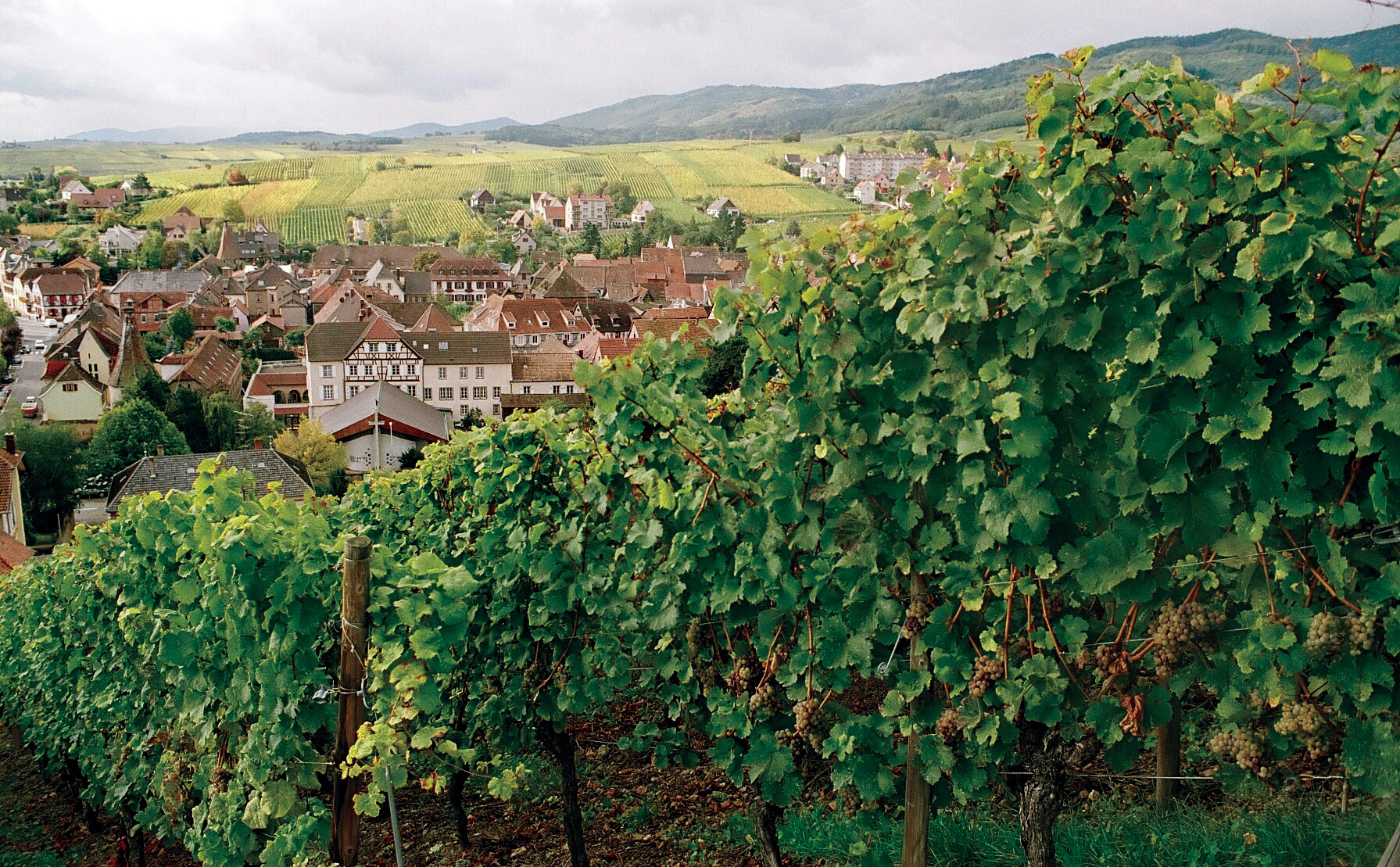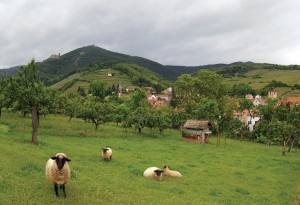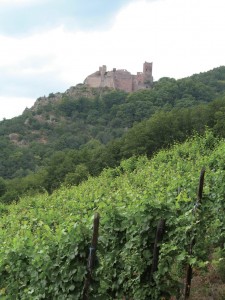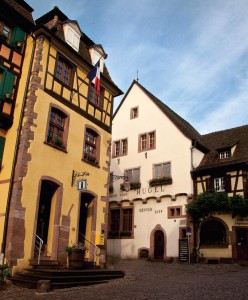by Bonnie and Tim Stevens
Strung together like a necklace in the northeast of France are the fairy tale villages of the Alsace. Here, surrounded by neatly tended, vine-covered slopes, sit clusters of half-timbered houses with carved lintels, delicate iron work signs, and colorful window boxes. You might well think you were in the heart of Germany or Austria, especially with the Germanic sounding names that reflect the area’slong, turbulent history.
The Route des Vins d’Alsace is one of the oldest wine routes in France, and by far the best way to explore its many charming villages and ruined castles is to drive. However, at over 200 miles long stretching from Marlenheim (west of Strasbourg) to Thann (near Mulhouse), it is really too long for one trip. Read the guidebooks and select a section which particularly appeals to you—chances are you’ll find much to enjoy, no matter where you end up.
Should you wish to explore on foot, there are dozens of trails through the vineyards between Bergheim and Ribeauville. Each trail provides an insight into the specific character of the area and its wine, together with spectacular views across the terraces, villages, and low mountains. It is an exciting voyage of discovery, as many of the villages hold lively wine fairs and other festivals between April and November, during which time you can join in the tasting and celebrations.
We always enjoy meeting the people of the localities we visit; this is the best way to find the interesting characters and see how they live and work. In talking to the farmers and winegrowers, you will likely discover that in these areas, making wine is more about passion than it is about making a fortune. Happily, throughout the year visitors are always welcome to taste and critique the wines in any of the village producers’ cellars. Wandering through the maze of cobbled side streets adds to the experience, as does sampling the Alsatian culinary creativity.
There are so many pristine and colorful villages that it is difficult to single out any particular favorite. All are impeccably clean and full of an abundance of colorful geraniums tumbling from balconies and window boxes. Many of the roofs are covered in locally-made tiles called biberschwanz (‘beaver’s tail,’ so named for the pattern they create), which enable the snow to slide off in winter. A more spectacular village is Haut-Koenigsbourg, with its castle standing guard high above the patchwork vineyards. Now a museum, this medieval fortress was once home to the Habsburg family and the German emperor Willhelm II. The enormous and impressive fortification, dating from the 12th century, stretches for 500 yards from end to end.
Not to be eclipsed by Haut-Koenigsbourg, Ribeauville has three medieval castles—sentinels built by the Ribeaupierre family over 600 years ago. The village of Ribeauville also boasts what is arguably the best Alsatian family wine producer, Maison Trimbach, now in its 13th generation of wine making. As one may imagine, Maison Trimbach offers the opportunity for a truly extraordinary wine tasting—all 26 threestar Michelin restaurants in France, and seemingly those in every other country, offer Trimbach wines. These wines are luscious with fruit but bone dry, contrary to many people’s expectations. As sophisticated as they may be, they still shout quality from the first cautious sniff through to the lingering multi-layered flavors on the palate. One can easily pay over ¥10,000 for the special wines of older vintages, but for those of us who don’t have such large budgets, it is possible to enjoy a truly memorable experience at a fraction of the cost.
Trimbach wines are available worldwide, including in Japan, with over one million bottles sold annually. The Bruno Sorg family winery is on a different scale, with most bottles sold direct from their picturesque Eguisheim village center farm complex. Not as dry as Trimbach, their wines are nevertheless full of fruit, well respected by connoisseurs,and can be tasted on the spot without an appointment. If you’re lucky you may even get the chance to have a chat with Bruno himself between his check-ups on the vineyards and vats.
Eguisheim, in our opinion, is somewhat over-run with tourists and rather Disney-like, however if you venture into the side alleyways, you will find its real soul. It was around this village that the Romans started making the first wines in Alsace, in the fourth century. Here, as in Riquewihr, visitors must park on the outskirts in order to prevent the otherwise inevitable congestion. The village is opulent with flowers—the usual cascading geraniums—and grand houses, many sporting coats of arms, on the main street. In the village center are working farms chock-full of wine cellars, eateries, fountains, stately manors, and very colorful houses. We ate in the delightful family-run restaurant Caveau d’Eguisheim in a pleasant, heavily-timbered building in the heart of the village. The lady of the house, who turned out to be the chef’s mother, rushed briskly from table to table, taking orders, pouring wine, and serving food. But in spite of only having her daughter to assist in the front of the house, and despite the obvious strain, she managed to keep things on track. A charming collection of pottery chickens dotted throughout turned out to be the chef Jean-Christophe’s other passion (the first being cooking).
The food was sophisticated, elegant, and refined, as would be expected from a chef with Jean-Christophe Perrin’s credentials—he trained at the acclaimed Michelin three-star Troisgros restaurant in Roanne.
In the peak summer months, the Route des Vins can get crowded with visitors and cars, but when the weather is more comfortable in the spring and autumn, the area is absolutely lovely. The autumn is particularly striking, with the red, orange and golden slopes tumbling down to the valleys redolent with the smell of freshly pressed grapes.
As a contrast to the small villages all along the Route des Vins, follow your soul and forget the map—visit the university city of Nancy. This enchanting place has a style, vibrancy, and freshness escaped by the larger Strasbourg with its global designer brand boutiques and hordes of tourists. The sheer exuberance of the 18th century architecture around the main square, Place Stanislas, is enough to stop you in your tracks. Grand, elegant, and delicate yet imposing classical buildings on all sides and playing fountains add to the joyful setting.
The square represents just one chapter in Nancy’s long history; there has been a community here for a millennium. Perversely, the old city center is called the ‘new town,’ and here you will find a softer form of architecture than that of the three formal squares. The city has quickly shrugged off its 19th century heavy industry image over the last decades to expose layer upon layer of history.
Nancy was at Europe’s forefront with Art Nouveau. An influential leading local artist was the famed Emile Gallé, best known for his art glass. A friend and inspiration for some of his work was Hokusai, who also lived for a while in Nancy. Amongst the numerous Art Nouveau buildings is the L’Excelsior brasserie, an excellent example of the style and the perfect place to feast on delicious foie gras accompanied by a sublime Pinot Gris at the end of a long day of sightseeing.
Photos by Bonnie Stevens, Allan Harris, Ino Paap, and Adam Baker
External Links:
Alsace Wines
Alsace Travel Guide












